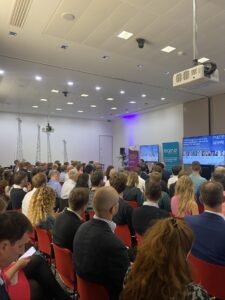One thing that all low carbon energy projects have in common is the need for a connection to the grid. Connecting to the grid is now perhaps the biggest challenge for developers of solar farms, battery storage and electric vehicle charging facilities – as well as for our net zero ambitions more generally.

To address the challenge, we now have action plans from the the Electricity System Operator (ESO) and Energy Networks Association (ENA), far-reaching grid reform proposals out for consultation from the ESO and an action plan due from the Department for Energy Security and Net Zero (DESNZ) and Ofgem. The focus from decision makers on reform of the dysfunctional connection process is welcome. However, these changes will have significant implications for investors and developers, introducing milestones and a ‘gated’ process that will shift the dynamic of project development.
In October 2023, Regen brought together leading players in connections reform to our event in Bristol. The aim of the event was to enable industry to discuss with DESNZ, Ofgem, ESO and ENA their plans to address the increasingly acute grid connection challenge and how our sector can shape changes at this critical stage. Here is a summary of the key takeaways.
DESNZ and Ofgem aligned on importance of the grid connections challenge
It’s clear that grid connections have risen up the agenda in Westminster and Whitehall, with even the Prime Minister talking about the importance of a ‘first ready, first connected’ approach to connections. DESNZ and Ofgem confirmed they will be publishing a Connections Action Plan ‘shortly’, providing government and regulator support to deliver the proposals being developed by ESO and ENA to address the connections queue.
‘Retrospective’ queue management at transmission seems increasingly likely
Queue management was, predictably, a hot topic. Both DESNZ and Ofgem were clear on the importance of taking a holistic approach. We are now expecting a decision from Ofgem on CMP376, which will introduce a right for the ESO to terminate projects not progressing against agreed milestones. Given the political focus on this issue, it seems increasingly likely that Ofgem will support ESO’s proposal that queue management milestones are applied to the whole queue, not just new projects.
Coordination, communication and transparency are key
ESO and ENA updated on progress against their Five- and Three-Point Plans to address the connections queue. These measures are now moving into implementation, with new offers expected to come through from November.
A key piece of feedback from the audience was that communication and coordination need to be improved. There is currently a ‘postcode lottery’ in how new measures are being applied, with lack of coordination between transmission and distribution and between different network operators. Getting the comms right is crucial so that everyone has the opportunity to participate in new initiatives and to ensure the process is fair.
Fundamental reform to the connections process is welcome, but the queue must be addressed first
The ESO’s ‘GB Connections Reform’ is developing an entirely new process for managing new connections, based on milestones and gates. Key issues in this process include:
- How frequent connection application windows are
- What the details of milestones and gates are
- How distribution connections are treated so as not to get stuck in a long process designed for transmission connected projects.
The sense from the room was that this reform is broadly welcomed, depending on the detail. However, delegates were clear that a new process will have little impact if the current queue is not addressed.
ESO will be publishing their final recommendations in November. Regen is shaping proposals via our position on the reform Steering Group.
Battery storage connections continue to dominate the contracted pipeline
We heard from ESO that the contracted pipeline includes 50 GW of stand-alone and 100 GW of hybrid/co-located battery capacity. ENA confirmed there was 60 GW of contracted sites at distribution scale. This takes the total contracted pipeline to over 200 GW (including co-located capacity) and approximately 100 GW of stand-alone.
Ofgem wrote a letter in August in support of tactical solutions put forward by ENA to help with storage connections at distribution. Guidance for network operators has now been published. These changes will impact new connections from 31 September and the new approach will move network operators from the current worst case assumptions being used to assess the impact of battery storage on the network. It is yet to be confirmed whether this will be used for existing sites, and whether there will be an option for updated connection offers.
It is important for industry to engage
With so much change underway and significant implications for developers and investors, it’s clearly important for our industry to engage. Regen runs a quarterly Grid Connections Working Group for members, where we discuss the various connections reforms and coordinate action. We invite you to join us. Please contact Estelle Limon, Policy and Impact Manager, at elimon@regen.co.uk.
